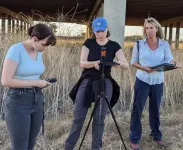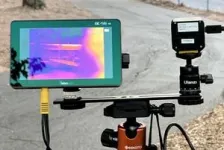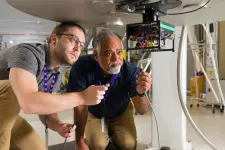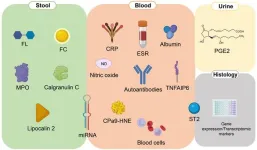(Press-News.org) Preventing the next pandemic begins before diseases emerge. This “pre-emergence” phase is the focus of a new center funded by the U.S. National Science Foundation and led by the University of California, Davis.
Supported with $18 million over seven years, the U.S. National Science Foundation Center for Pandemic Insights (NSF CPI) includes partnering institutions from across the United States. It aims to harness new technologies and develop sensing to detect, investigate, and ultimately prevent pandemics at their source.
Funded through NSF’s Predictive Intelligence for Pandemic Prevention (PIPP) program, the center includes 11 partnering institutions from across the United States. It also blends four UC Davis powerhouses: the School of Veterinary Medicine, College of Engineering, College of Agricultural and Environmental Sciences, and the School of Medicine.
“This center is a moonshot for being able to transform how we do investigations into the pre-emergence phase for pandemics,” said center lead Christine K. Johnson, a professor of epidemiology and ecosystem health in the UC Davis School of Veterinary Medicine and director of the EpiCenter for Disease Dynamics in its One Health Institute. “We’ll be able to optimize cutting-edge technology that’s already being applied in areas of human health, engineering and agriculture and bring them into this important space to help with wildlife and pandemic threats.”
Sensing a pandemic
Most pandemics are caused by emerging infectious diseases that originate in wildlife and are detected only after causing outbreaks in humans. The complex nature of infectious diseases limits the ability of scientists to conduct targeted surveillance and gather data at the speed or scale needed to detect pandemic threats.
Meanwhile, preventing pandemics requires a deep understanding of viruses where they naturally occur. This includes knowledge of disease cycles in wild animal hosts and how these disease cycles interact with people on the landscape. Those interactions occur at the pre-emergence phase of pandemics.
Johnson envisions sensor systems similar to those used for forecasting unusual weather events or earthquakes – one with access to high quality data “at key fault lines for virus emergence.”
Center scientists aim to:
Study how epidemics cycle in nature, looking at animals that are the natural reservoirs for viruses. They will create models to understand how diseases may spill over before developing into pandemics.
Create sensor networks that can detect disease cycles in nature.
Fine-tune insights into pandemic risk using advanced computer programs that mix model predictions with sensor data.
Together, these efforts can enable large-scale, safe and efficient monitoring for emerging diseases.
Putting it together
How might this look in the field? The team has been piloting strategies to sense animal movement and diseases across a range of species—from bats to birds to primates and more. Such noninvasive techniques allow scientists to collect data without handling wildlife, as well as access terrain that makes physically monitoring wildlife challenging.
Examples of UC Davis’ transdisciplinary work with the center include remote environmental sensing from Plant Sciences Associate Professor Troy Magney. Semiconductor technology from Professor Cristina Davis in the College of Engineering, which collects and analyzes volatile organic chemicals in the air. Expertise from co-lead Simon Anthony, associate professor in the UC Davis School of Veterinary Medicine, adds to the group’s deep inquiry into the ecological and evolutionary drivers of disease emergence. Combined, this kind of data can help alert scientists to real-time changes in the environment and among wildlife that warrant closer inspection.
“We are all too aware of the challenges we’ve been facing, and we’re well poised to inform on the solutions,” Johnson said. “We’ve strategically built our partnerships to bring together missing pieces to meet those challenges. With this center, I think we’ll have a much-improved shot of being able to bring new insights into the changing landscape of pandemics.”
Partnering institutions that will lead a range of center activities include the University of Southern California, Northeastern University, Labyrinth Global Health, Texas Tech University, San Diego Zoo Wildlife Alliance, UC Los Angeles, Albert Einstein College of Medicine, University of Michigan, UC San Diego, and Colorado State University.
“Research on emerging infectious diseases is a critical investment in our future, and it necessitates a collaborative approach that spans multiple disciplines and sectors and incorporates the newest tools and technology,” said NSF Director Sethuraman Panchanathan. “By bringing together experts in biology, computer science and artificial intelligence, engineering and more, these investments are well positioned to predict, prevent and respond to potential pandemics across all forms of life, thus safeguarding the health, economic stability and security of our nation.”
END
New NSF Center for Pandemic Insights
Center draws from health, engineering, agriculture, social sciences to advance pandemic science for emerging threats
2024-08-22
ELSE PRESS RELEASES FROM THIS DATE:
FAMU-FSU College of Engineering research shows how insulin, zinc and pH can block harmful protein clumps linked to Type 2 diabetes
2024-08-22
An estimated 462 million people around the world suffer from Type 2 diabetes, a chronic disease in which the body has problems using sugar as a fuel, leading to a buildup of sugar in the blood and chronic health issues.
New research led by Ayyalusamy Ramamoorthy, a professor at the FAMU-FSU College of Engineering and the Florida State University-headquartered National High Magnetic Field Laboratory, shows how zinc, pH levels and insulin work together to inhibit the buildup of protein clumps that contribute to this disease. The work, which points toward promising avenues for innovative treatments, ...
Fecal, blood, and urinary biomarkers in inflammatory bowel diseases
2024-08-22
The global burden of inflammatory bowel diseases (IBD), primarily Crohn's disease (CD) and ulcerative colitis (UC), continues to rise. Recent data show incidence rates of up to 17.8 cases per 100,000 person-years for CD and even higher for UC, reaching 28.4 per 100,000 person-years. These diseases primarily affect older populations and vary geographically, with higher prevalence rates in highly developed countries. Currently, endoscopic assessment through ileo-colonoscopy is the gold standard for diagnosing and monitoring IBD. However, this approach is invasive and often has limited availability, leading to long ...
ARDD 2024 | What can we do before the "cliff" of aging arrives?
2024-08-22
When exactly does the aging process start? With the aging mechanisms unclear, no consensus has been reached about aging “cliffs”, where our body functions and biological processes just change dramatically, as if overnight.
In 2019, a study published in the authoritative peer-reviewed journal Nature Medicine, based on plasma proteomics data, identified 34, 60, and 78 years old as key time points of aging. In August 2024, Nature Aging, a Nature portfolio journal focusing on aging mechanisms, published the latest findings incorporating comprehensive data including transcriptomics and metabolomics, pinpointing the aging cliffs to the 40s and 60s.
In the biomedical field, multi-omics ...
Hydrogels can play Pong by “remembering” previous patterns of electrical simulation
2024-08-22
Non-living hydrogels can play the video game Pong and improve their gameplay with more experience, researchers report August 23 in the Cell Press journal Cell Reports Physical Science. The researchers hooked hydrogels up to a virtual game environment and then applied a feedback loop between the hydrogel’s paddle—encoded by the distribution of charged particles within the hydrogel—and the ball’s position—encoded by electrical stimulation. With practice, the hydrogel’s accuracy improved by up to 10%, resulting in longer rallies. The researchers say that this demonstrates ...
Precision drug olaparib may be effective without hormone therapy for some men with biochemically recurrent prostate cancer
2024-08-22
The anti-cancer drug olaparib may be effective in treating biochemically recurrent prostate cancer without accompanying hormone therapy for men who have mutations in genes such as BRCA2, according to results of a phase II clinical trial of 51 patients conducted at the Johns Hopkins Kimmel Cancer Center and three other sites.
The study was done of men experiencing signs of cancer recurrence after surgical removal of the prostate, as measured by a high level of the protein prostate-specific antigen (PSA). Following treatment with olaparib, 13 participants, including all 11 who had BRCA2 mutations, had a decrease in PSA of at least 50% ...
Americans face disparities in exposure to tobacco on streaming platforms
2024-08-22
Tens of millions of Americans are being exposed to tobacco content on streaming services, according to new research from The University of Texas MD Anderson Cancer Center. The researchers found that the odds of encountering tobacco products being advertised, marketed or promoted on these platforms increased based on race, ethnicity, socioeconomic status and smoking habits.
The nationally representative study, published today in JAMA Network, revealed an estimated 12.4% of American adults were exposed to tobacco promotion on streaming services. Exposure was highest among those with a high school education or less (16.4%), Black/African American respondents (19.4%), ...
Elinzanetant for the treatment of vasomotor symptoms associated with menopause
2024-08-22
About The Study: In two pivotal phase 3 clinical trials, elinzanetant, a selective neurokinin-1,3 receptor antagonist, demonstrated statistically significant reductions in vasomotor symptoms (VMS) frequency and severity vs placebo in postmenopausal individuals with moderate to severe VMS. Elinzanetant also significantly improved sleep disturbances and menopause-related quality of life vs placebo; the safety profile was favorable.
Corresponding Author: To contact the corresponding author, JoAnn V. Pinkerton, ...
Trends in children’s exposure to food and beverage advertising on television
2024-08-22
About The Study: In this repeated cross-sectional study of children’s exposure to food-related television advertisements, exposure via children’s programming decreased substantially. However, most advertisements seen were still for unhealthy products, and exposure from all programming remained substantial. Findings of more than 90% of advertising exposure not from children’s programming and more than 1,000 food-related advertisements seen per year suggest the need for government regulations based on time of day rather than programming.
Corresponding Author: To contact the corresponding author, Lisa M. Powell, PhD, email powelll@uic.edu.
To ...
Disparities in exposure to tobacco on television or streaming platforms
2024-08-22
About The Study: In this study of the prevalence of exposure to tobacco advertisements on TV or streaming platforms among U.S. adults, disparities in exposure by race or ethnicity, education level, and smoking status were identified. These findings underscore the need for targeted public health interventions and regulation to address these disparities and reduce the impact of tobacco advertisements on vulnerable populations.
Corresponding Author: To contact the corresponding author, Sanjay Shete, PhD, email sshete@mdanderson.org.
To access the embargoed study: Visit our For The Media website at this link https://media.jamanetwork.com/
(doi:10.1001/jamanetworkopen.2024.27781)
Editor’s ...
How thyroid hormone fuels the drive to explore
2024-08-22
Thyroid hormone plays a key role in regulating a range of physiologic functions, including metabolism, temperature, heart rate, and growth. It accomplishes this impressive array of activities by interacting with almost every organ system in the body. Yet despite a long history of research on how thyroid hormone influences different organs, its effects on arguably the most crucial organ — the brain — have remained shrouded in mystery.
Now, scientists at Harvard Medical School have gained ...
LAST 30 PRESS RELEASES:
What determines the fate of a T cell?
Candida auris: genetic process revealed which could be treatment target for deadly fungal disease
Groundbreaking discovery turns household plastic recycling into anti-cancer medication
Blocking a key inflammatory pathway improves liver structure and vascular function in cirrhosis, study finds
Continuous spread: Raccoon roundworm detected in nine European countries
HKUST Engineering researchers developed a novel photodetector to enhance the performance of on-chip light monitoring
Strategic river sensors could have forewarned of Texas Camp flood disaster
Drone sampling of whale breath reveals first evidence of potentially deadly virus in Arctic
Roman soldiers defending Hadrian’s Wall infected by parasites, study finds
Pinochet’s prisoners were tormented with music but still found solace in it, a new book reveals
Fertility remains high in rural Tanzania despite access to family planning
AI-assisted device can improve autism care access
Kinetic careers
Uncovering how parasitic plants avoid attacking themselves to improve crop resistance
Nanoparticle vaccine strategy could protect against Ebola and other deadly filoviruses
Study finds brain care score can predict risk of stroke across racial groups
Key lung immune cells can intensify allergic reactions
Do hormones explain why women experience more gut pain?
New materials conduct ions in solids as easily as in liquids
Breakthrough of the Year: Renewable energy begins to eclipse fossil fuel-based sources
LLM use is reshaping scientific enterprise by increasing output, reducing quality and more
Introducing LightGen, a chip for ultra-fast, ultra-efficient generative AI
Astronomers see fireworks from violent collisions around nearby star
ACC/AHA issue new guideline on managing congenital heart disease in adults
Cosmic crash caught on camera
Is talented youth nurtured the wrong way? New study shows: top performers develop differently than assumed
Ants: An untapped resource in the development of antibiotics?
Archaeologists use AI to create prehistoric video game
Mitochondria migrate toward the cell membrane in response to high glucose levels
Tiny viral switch offers hope against drug-resistant bacteria
[Press-News.org] New NSF Center for Pandemic InsightsCenter draws from health, engineering, agriculture, social sciences to advance pandemic science for emerging threats







